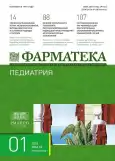Dynamics of laboratory blood parameters in children with atopic dermatitis who received biological therapy with AN IL-4, IL-13 inhibitor in combination with topical therapy methods
- Autores: Rusakova L.L.1,2, Murashkin N.N.1,3,4
-
Afiliações:
- National Medical Research Center for Children’s Health
- Bryansk Regional Skin and Venereal Diseases Dispensary
- I.M. Sechenov First Moscow State Medical University (Sechenov University)
- Central State Medical Academy of the Administrative Directorate of the President of the Russian Federation
- Edição: Volume 32, Nº S1 (2025)
- Páginas: 40-49
- Seção: Original articles
- ##submission.datePublished##: 08.11.2025
- URL: https://journals.eco-vector.com/2073-4034/article/view/687877
- DOI: https://doi.org/10.18565/pharmateca.2025.1-s1.40-49
- ID: 687877
Citar
Texto integral
Resumo
Objective: Evaluation of the dynamics of laboratory blood parameters and the safety of using an IL-4, IL-13 inhibitor (dupilumab) in combination with topical therapy methods in children over 2 years of age with moderate and severe atopic dermatitis in the aspect of 2-year follow-up.
Materials and methods: A 2-year observational study was conducted in 120 children aged 2 to 17 years with atopic dermatitis who received biological therapy with dupilumab in combination with topical therapy methods. Patients were divided into 3 groups by the nature of the therapy. At the 16th, 28th, 52nd, 64th, 104th week of follow-up, all patients underwent laboratory clinical blood and urine tests, a biochemical blood test, and a study of the total IgE level.
Results: The effect of the IL-4, IL-13 inhibitor (dupilumab) in combination with various methods of topical therapy in children with AD during a 2-year follow-up showed that the dynamics of blood biochemical parameters did not undergo statistically significant changes (p>0.05). In all groups, these parameters were within the reference values throughout the follow-up period. Laboratory parameters of the complete blood count showed minor eosinophilia, which decreased to normal values with continued treatment. No statistically significant changes were found in the complete urine analysis either. And when assessing the IgE level, a stable statistically significant (p<0.05) decrease in laboratory parameters was observed from period to period.
Conclusion: Long-term assessment of the dynamics of laboratory parameters in children over 2 years old with moderate and severe AD in the context of 2-year follow-up who received dupilumab in combination with complex methods of topical therapy demonstrated no need for laboratory monitoring and confirmed the safety and efficacy of this therapy and prevention of AD exacerbations, which indicates the advisability of supplementing the complex treatment algorithm.
Texto integral
Sobre autores
Lyudmila Rusakova
National Medical Research Center for Children’s Health; Bryansk Regional Skin and Venereal Diseases Dispensary
Email: m_nn2001@mail.ru
ORCID ID: 0000-0003-4297-4631
Junior Researcher, Laboratory of Skin Pathology in Children, Deputy Chief Physician for Medical Affairs, Chief Specialist in Dermatovenereology and Cosmetology, Bryansk Regional Health Department
Rússia, Moscow; BryanskNikolay Murashkin
National Medical Research Center for Children’s Health; I.M. Sechenov First Moscow State Medical University (Sechenov University); Central State Medical Academy of the Administrative Directorate of the President of the Russian Federation
Autor responsável pela correspondência
Email: m_nn2001@mail.ru
ORCID ID: 0000-0003-2252-8570
Dr. Sci. (Med.), Professor, Head of the Research Institute of Pediatric Dermatology, Head of the Department of Dermatology and Allergology, Head of the Laboratory of Skin Pathology in Children, Department of Scientific Research in Pediatrics, Professor Department of Dermatovenereology and Cosmetology, Professor Department of Pediatrics and Pediatric Rheumatology
Rússia, Moscow; Moscow; MoscowBibliografia
- Коннов П.Е., Арсеньева А.А. Эффективность и безопасность применения первого таргетного биологического препарата Дупилумаб в терапии тяжелого непрерывно-рецидивирующего атопического дерматита. Вестник дерматологии и венерологии. 2023;99(1):62–70. [Konnov P.E., Arsenieva A.A. Efficacy and safety of the first targeted biological drug dupilumab in the treatment of severe continuously relapsing atopic dermatitis. Vestnik Dermatologii i Venerologii. 2023;99(1):62–70. (In Russ.)]. doi: https://doi.org/10.25208/ vdv1384
- Зайнуллина О.Н., Хисматуллина З.Р., Печкуров Д.В. Проактивная терапия атопического дерматита у детей с применением эмолентов. Клиническая дерматология и венерология. 2020;19(1):87–91. [Zajnullina O.N., Xismatulina Z.R., Pechkurov D.V. Proactive therapy of atopic dermatitis in children using emollients. Klinicheskaya dermatologiya i venerologiya. 2020;19(1):87–91. (In Russ.)]. doi: https://doi.org/10.17116/klinderma20201901187
- Paller A.S., Siegfried, E.C., Cork, M.J. et al. Laboratory Safety from a Randomized 16-Week Phase III Study of Dupilumab in Children Aged 6 Months to 5 Years with Moderate-to-Severe Atopic Dermatitis. Pediatr Drugs. 2023;25:67–77. doi: https://doi.org/10.1007/s40272-022-00553-8
- Weidinger S., Beck L.A., Bieber T., et al. Atopic dermatitis. Nat Rev Dis Primers. 2018;4(1):1. doi: https://doi.org/10.1038/s41572-018-0001-z.
- Boguniewicz M., Alexis A.F., Beck L.A., et al. Expert Perspectives on Management of Moderate-to-Severe Atopic Dermatitis: A Multidisciplinary Consensus Addressing Current and Emerging Therapies. J Allergy Clin Immunol Pract. 2017 Nov-Dec;5(6):1519–1531. doi: https://doi.org/10.1016/j.jaip.2017.08.005
- Wollenberg A., Beck L.A., Blauvelt A., et al. Laboratory safety of dupilumab in moderate-to-severe atopic dermatitis: results from three phase III trials (LIBERTY AD SOLO 1, LIBERTY AD SOLO 2, LIBERTY AD CHRONOS). Br J Dermatol. 2020 May;182(5):1120-1135. doi: https://doi.org/10.1111/bjd.18434
- Arkwright P.D., Motala C., Subramanian H., et al.; Atopic Dermatitis Working Group of the Allergic Skin Diseases Committee of the AAAAI. Management of difficult-to-treat atopic dermatitis. J Allergy Clin Immunol Pract. 2013 Mar;1(2):142–51. doi: https://doi.org/10.1016/j.jaip.2012.09.002
- Drucker A.M., Eyerick K., de Bruin-Weller M., et al. Use of systemic corticosteroids for atopic dermatitis: International Eczema Council consensus statement. Br J Dermatol. 2018;178(3):768–75.
- Paller A.S., Wollenberg A., Siegfried E., et al. Laboratory Safety of Dupilumab in Patients Aged 6-11 Years with Severe Atopic Dermatitis: Results from a Phase III Clinical Trial. Paediatr Drugs. 2021 Sep;23(5):515–527. doi: https://doi.org/10.1007/s40272-021-00459-x
- Siegfried E.C., Bieber T., Simpson E.L., et al. Effect of Dupilumab on Laboratory Parameters in Adolescents with Atopic Dermatitis: Results from a Randomized, Placebo-Controlled, Phase 3 Clinical Trial. Am J Clin Dermatol. 2021 Mar;22(2):243–255. doi: https://doi.org/10.1007/s40257-020-00583-3
- Le Floc’h A., Allinne J., Nagashima K., et al. Dual blockade of IL-4 and IL-13 with dupilumab, an IL-4Rα antibody, is required to broadly inhibit type 2 inflammation. Allergy. 2020 May;75(5):1188–1204. doi: https://doi.org/10.1111/all.14151
Arquivos suplementares




























